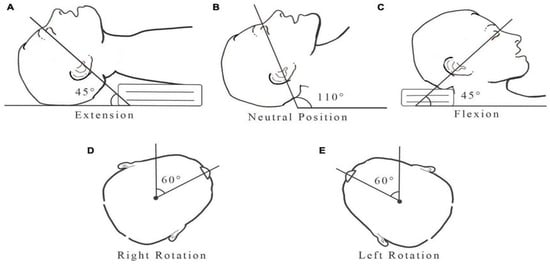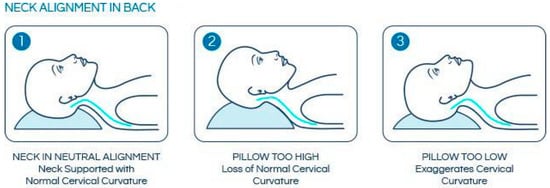1. Introduction
Cervical discomfort during prolonged dental treatments is a well-documented and frequent issue in clinical practice. Poor cervical posture can lead to muscle fatigue, paresthesia, and chronic pain, significantly diminishing patient experience and potentially compromising the quality of dental interventions. Addressing ergonomic factors is essential for optimizing both patient comfort and the efficacy of treatment delivery. This research focuses on the design and prototyping of an intelligent ergonomic support system aimed at monitoring and correcting cervical alignment in real-time during dental procedures.
2. Aim
The main objective is to develop a medical device that supports and maintains the neutral posture of the cervical spine while also monitoring angular deviations from this position during dental interventions in real-time. The neutral posture is defined as the midpoint between full extension (approximately 45°) and full flexion (also approximately 45°), with a resting head-neck angle of approximately 110°. Additionally, the system tracks cervical rotation, where normal range is approximately 60° to the right and left. Any deviation beyond these ranges may result in biomechanical strain or discomfort, which the device is designed to detect and correct.
3. Methods
The design and development of the device involved several phases:
1. Postural Analysis: Initial assessments were conducted to define the parameters of the cervical posture typically observed during dental treatments. The neutral cervical position was defined based on the ergonomic literature and measurements of the cervical range of motion (ROM) in flexion, extension, and lateral rotation (Figure 1).

Figure 1.
Cervical range of motion reference angles used in device calibration [].
2. Ergonomic Support Design: A cervical pad was modeled to conform to the physiological cervical curvature, supporting the head and neck in a neutral alignment. Materials were selected based on flexibility, support capacity, and patient comfort.
3. Sensor Integration: Inertial Measurement Unit (IMU) sensors were embedded within the support to continuously monitor head and neck positions. The IMUs capture angular changes in three planes, transmitting data to a central processor.
4. Feedback Mechanism: A real-time alert system was implemented to notify the clinician if the cervical deviation exceeds predefined ergonomic thresholds (e.g., ±10° for caution, >45° for immediate correction). Feedback was delivered via visual (LED indicators) and/or auditory cues.
5. Simulation and Validation: The prototype was tested in simulated dental sessions with human participants, comparing postural data and subjective comfort assessments between the standard and ergonomic setups.
4. Results
The prototyped version of the device effectively maintained neutral neck alignment9 (Figure 2) in 90% of clinical simulation cases. The integrated sensor system reliably detected angular deviations outside of ±10° and responded with real-time corrective alerts. Participants reported increased comfort levels and reduced cervical fatigue during simulated procedures compared to standard dental headrests.

Figure 2.
Cervical alignment comparison neutral vs. misaligned posture [].
5. Conclusions
Maintaining cervical neutrality is critical during long-duration dental procedures to prevent patient discomfort and long-term musculoskeletal complications. The smart support device designed in this project represents a promising advancement in ergonomic dentistry, offering benefits for both patients and dental professionals. With further development and clinical testing, the system has the potential to become a standard tool in dental operatory setups.
6. Future Directions
- -
- Integration with artificial intelligence (AI) for automated posture correction.
- -
- Customizable support shapes tailored to individual cervical anatomy.
- -
- Large-scale clinical trials to validate device efficacy in diverse patient populations.
Author Contributions
Conceptualization, E.R., C.S. and A.C.N.; methodology, E.R., C.S. and M.-L.N.; formal analysis, C.S., E.C.A. and A.C.N.; writing—original draft preparation, E.R. and A.C.N.; supervision, C.S., M.-L.N. and E.C.A. All authors have read and agreed to the published version of the manuscript.
Funding
This research received no external funding.
Institutional Review Board Statement
Ethical review and approval Nr. 83/01.10.2024.
Informed Consent Statement
Ethical approval Nr. 83/01.10.2024.
Data Availability Statement
Data is contained within the article.
Conflicts of Interest
The authors declare no conflicts of interest. The funders had no role in the design of the study; in the collection, analyses, or interpretation of data; in the writing of the manuscript; or in the decision to publish the results.
References
- Zhuang, P.; Wang, W.; Cheng, M. Effect of head position changes on the depth of tracheal intubation in pediatric patients: A prospective, observational study. Front. Pediatr. 2022, 11, 998294. [Google Scholar] [CrossRef] [PubMed]
- Neck Alignment in Back Sleeping. Available online: https://saletidemk.click/product_tag/4950190_.html (accessed on 3 November 2025).
Disclaimer/Publisher’s Note: The statements, opinions and data contained in all publications are solely those of the individual author(s) and contributor(s) and not of MDPI and/or the editor(s). MDPI and/or the editor(s) disclaim responsibility for any injury to people or property resulting from any ideas, methods, instructions or products referred to in the content. |
© 2025 by the authors. Licensee MDPI, Basel, Switzerland. This article is an open access article distributed under the terms and conditions of the Creative Commons Attribution (CC BY) license (https://creativecommons.org/licenses/by/4.0/).